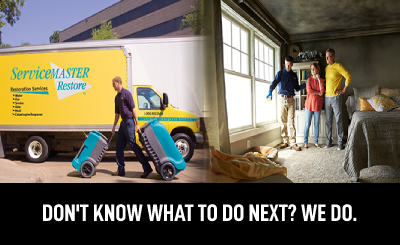Damage Control – Useful Disaster Recovery Tips For Chicago Businesses and Property Managers – ServiceMaster Restoration By Simons – Chicago’s Trusted Name For Fire & Water Damage Restoration & Disaster Recovery
Disaster Recovery: Do’s and Don’ts.
Water Damage, Fire Damage or Smoke Damage can wreak havoc on a building. But there are some very simple damage control principles to follow so the cleanup process goes smoothly:
After damage from a fire, water leaks, or smoke, what you do first can make a big difference — for good or bad. While you want to restore some sense of normalcy to your space and your employees/tenants, doing the wrong thing can make the damage worse and weaken your damage control efforts.
Fire and Smoke Damage
DO
- Blow off or brush-vacuum loose soot particles from upholstery, drapes, and carpets..
- Cover carpeted traffic areas with towels or old linens to prevent additional soiling — and “ground in” soot.
- Discard any open food packages (Food could be contaminated by chemicals released in the fire)
- Send clothing with heavy smoke damage to a professional restoration cleaner rather than a dry cleaner.
- Clean Formica and fixtures (both chrome and porcelain) in the bath and kitchen to prevent permanent tarnishing.
- Wipe the leaves of surviving plants to remove smoke residue.
- Change the furnace/AC filter.
- Tape damp cheesecloth over air outlets (both intake and output) to capture loose soot in the air (and to reduce damage to your system).
- If the outside temperature and security procedures will allow it, air out the building to reduce smoke odor.
DON’T
- Do not try to wash any papered or flat painted walls.
- Do not try to clean carpets or upholstered furniture.
- Do not use electrical appliances before they’ve been checked.
- Do not use ceiling fixtures before they’ve been checked.
- Try not to touch things — and keep your hands as clean as possible. Soot on your hands can ‘migrate’ to places that didn’t have any.
- Do not eat any food that has been exposed to fire or smoke.
- Do not wait to call for professional help — Response in the first 24 hours can make a HUGE difference in how much is saved.
Water Damage
DO
- Cut off the power, if you can do so without standing in a damp place.
- If the outside temperature and security procedures will allow it, air out the building, using dehumidifiers and fans.
- Remove as much water as possible by blotting or mopping.
- Wipe furniture dry.
- Lift draperies off the carpet.
- Prop up wet furniture cushions for even drying.
- Remove area rugs or floor coverings if wet.
- For wet furniture, if it has doors or drawers, open them to improve drying.
- Move photos, paintings, or other art objects to safe locations.
- Remove damp books from shelves and open to dry, flipping the pages from time to time.
- If it’s cold outside, leave your heat on. If it’s very hot, leave your AC on.
DON’T
- Do not use an ordinary vacuum to remove water.
- Don’t use electrical appliances on wet carpet or floors.
- Don’t go into rooms with standing water if the power is still turned on.
- Don’t lift the tacked-down carpet. (Doing this wrong could increase shrinkage — let the professionals handle it.)
- Don’t wait to call a professional. Water damage starts at once and gets worse as time passes. Bacterial growth can start in just a few hours. A professional response in the first 24 hours can make all the difference.
Getting Ready for Disaster
Just like a “fire escape plan,” the steps you take BEFORE disaster strikes can make a big difference in saving you time, money, and inconvenience.
You can’t prevent a disaster, but you can do more than just buy insurance. The steps you take BEFORE disaster strikes can make a big difference in saving you time, money, and inconvenience… and get you back in business faster.
Figure the odds. Make a list. — Consider what sort of disaster types and scenarios that could strike your building or business, starting with the “most likely.” Storms, fires, and burst pipes may be the most obvious. Floods, earthquakes, or tornados may be lower on the list. Even consider potential disasters like power failures, heating or cooling system shutdowns.
Pre-Qualify Outside Sources. Depending on the nature of the disaster, here are some people you might need.
- Structural Engineers
- Restoration Company
- Electrical Engineers
- Plumbers
- Communications Systems Specialists
- Building Contractors or Carpenters
- Again, don’t wait until after disaster strikes. Have company names and phone numbers of reliable sources ready as soon as you need them. Meet them and review references. Look at their actual experiences and the types of jobs they’ve done. Make sure you know their emergency response procedures — and how fast they will come to you after a disaster.
OTHER LISTS
Inventory all equipment and supplies. Don’t count on employee memories, especially after the shock of a disaster. These records will be critical for insurance claims. In addition to lists, video all property contents and structures. Store the lists and videos ELSEWHERE.
Have a communications plan for employees or tenants, so they know what to do or where to call during an emergency.
After the Disaster— Restore or Replace?
When flood or fire impacts your business, is it better to replace damaged objects? Or restore them? Use these helpful guidelines to help determine the best course of action for damage control.
Natural disasters like floods (or burst pipes) and fire can affect any building. As you consider the aftermath of a problem like this, whether alone or with your insurance adjuster, here are the facts that can help you decide your damage control path.
Consider restoring instead of replacing when:
- Restoration costs are less than 60% of replacement costs.
- Restoration will be faster and/or more convenient. (Don’t forget to consider the time that will be required to select replacements.)
Choose replacement when:
- It is faster or more convenient.
- If restoration cannot promise satisfactory results.
- What to Look For in a Restoration Vendor
Do they provide employee training programs for:
- Mitigating water, fire/smoke, and odors
- Restoration versus replacement
- Policyholder communications
- Up-to-date technology
- Ask for details about the vendor’s procedures:
How quickly do they respond?
- Do they estimate the time of completion and make updates on progress?
- Do they inventory items removed?
- Do they conduct a final walkthrough when the job is complete?
- For best results, take the time NOW to select a disaster restoration professional — do your “shopping” before you need to make that call.
Proper Drying
Water damage can be cripple building property if not dried properly. Help ensure moisture and humidity are removed appropriately to reduce additional damage.
Proper Drying Reduces Water Damage and Health Problems
Flood damage
If you think it only happens when rivers overflow in the rainy season, think again. If your building has any plumbing – be it the bathroom, the coffee maker, the water cooler, or the ice maker – you have a potential “flood” on your hands. A burst pipe or loose connection can leave you with a swamp where the wall-to-wall carpet used to be.
Proper drying and dehumidifying techniques can save time and money.
The Enemy – Moisture
Because of the way moisture and humidity work, areas that don’t seem “affected” by the water can be damaged within hours. High levels of indoor humidity can lead to mold and mildew damage and corrosion. Materials and equipment far from the “problem” can be damaged or ruined if humidity isn’t taken care of – quickly. A restoration professional can help reduce property loss by controlling the surrounding environment, creating a balanced drying system and removing water vapor from the air faster than it is released from wet materials. This will help wet materials dry faster, and protect dry materials and equipment from getting wet through the high humidity.
Two Kinds of Dehumidification
Desiccant dehumidification is probably what you expect. Room air is “pulled” across a drying agent that draws moisture out, helping the area to dry more quickly. Desiccant is the choice in colder temperatures for drying structures (like wood, floors, walls, and ceilings).
Refrigerant dehumidification also offers advantages. With this technique, ambient air is cooled below its dew point temperature – moisture is condensed – “sweated out” – of materials. Though this is a slower process, it is the best choice when:
- It’s very warm.
- Drying highly absorbent materials, like carpet and upholstery.
- Minimizing shrinkage is optimal.
If you need Damage Control like Fire Damage Restoration or Water Damage Restoration, call Servicemaster Restoration By Simons. We’ll get your property back to pre-loss conditions — FAST!








